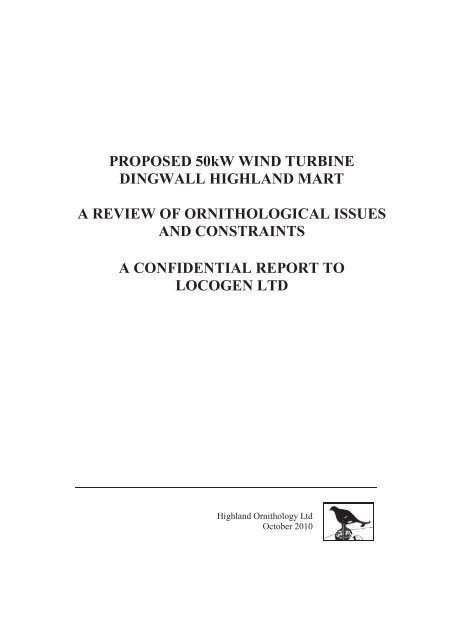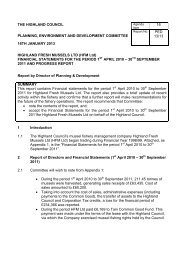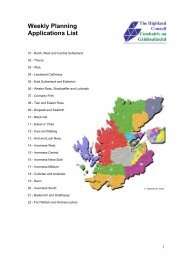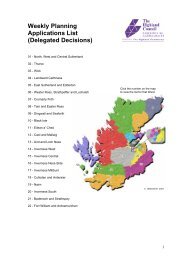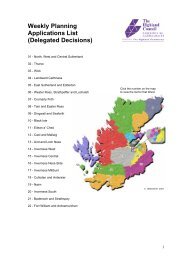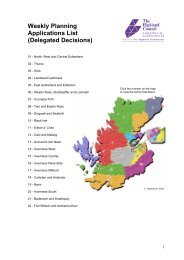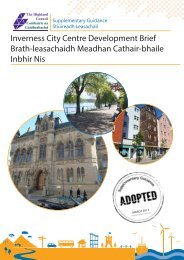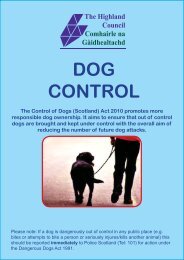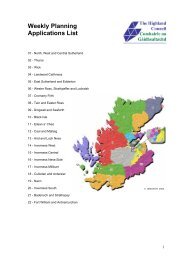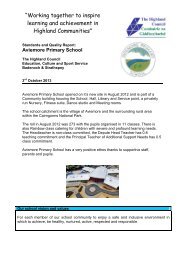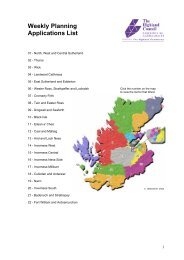Notice of Review 11-00044 Dingwall Highland
Notice of Review 11-00044 Dingwall Highland
Notice of Review 11-00044 Dingwall Highland
Create successful ePaper yourself
Turn your PDF publications into a flip-book with our unique Google optimized e-Paper software.
PROPOSED 50kW WIND TURBINE<br />
DINGWALL HIGHLAND MART<br />
A REVIEW OF ORNITHOLOGICAL ISSUES<br />
AND CONSTRAINTS<br />
A CONFIDENTIAL REPORT TO<br />
LOCOGEN LTD<br />
<strong>Highland</strong> Ornithology Ltd<br />
October 2010
PROPOSED 50kW WIND TURBINE:<br />
DINGWALL HIGHLAND MART<br />
A REVIEW OF ORNITHOLOGICAL ISSUES<br />
AND CONSTRAINTS<br />
Colin Crooke<br />
<strong>Highland</strong> Ornithology Ltd<br />
6 George Street<br />
Avoch<br />
Ross-shire<br />
IV9 8PU<br />
A confidential report to:<br />
Locogen Ltd<br />
<strong>11</strong> Maritime Street<br />
Edinburgh<br />
EH6 6SB<br />
On behalf <strong>of</strong>:<br />
The <strong>Dingwall</strong> <strong>Highland</strong> Mart<br />
October 2010
CONTENTS Page No.<br />
1. Introduction …………………………………………………….. 1<br />
2. Data search and consultation ........................................................ 2<br />
3. Details <strong>of</strong> site visit and general description <strong>of</strong> the turbine site area 3<br />
4. Ornithological review ................................................................... 4<br />
Whooper Swan Cygnus cygnus .............................................. 4<br />
Pink-footed Goose Anser brachyrhynchus................................. 5<br />
Greylag Goose Anser anser ...................................................... 7<br />
Osprey Pandion haliaetus ........................................................ 8<br />
Red Kite Milvus milvus ............................................................ 9<br />
5. Potential mitigation measures ...................................................... <strong>11</strong><br />
5.1 Measures relating to the migration and winter flight movements<br />
<strong>of</strong> Whooper Swans, Pink-footed and Greylag Geese ......... <strong>11</strong><br />
5.2 Measures relating to Red Kite ............................................. <strong>11</strong><br />
References<br />
List <strong>of</strong> Figures:<br />
Figure 1. Site layout, turbine location and favoured geese feeding areas.
1. Introduction<br />
The <strong>Dingwall</strong> <strong>Highland</strong> Mart are proposing to site a single 50kW wind turbine<br />
on a 35m tower, with a three blade turbine and a rotor diameter <strong>of</strong> 19.2m. The<br />
location <strong>of</strong> the proposed turbine is shown in Figure 1. Location <strong>of</strong> proposed<br />
50kW wind turbine <strong>Dingwall</strong> <strong>Highland</strong> Mart. The site location is on land<br />
owned by the <strong>Dingwall</strong> <strong>Highland</strong> Mart consisting <strong>of</strong> agricultural land above the<br />
cattle market buildings to the south west <strong>of</strong> the town <strong>of</strong> <strong>Dingwall</strong>.<br />
The project is being taken forward by Locogen Ltd an Edinburgh based<br />
company and early discussion with Scottish Natural Heritage (SNH) have been<br />
undertaken in connection with potential environmental impacts.<br />
SNH have expressed concerns about the development in relation to the turbine<br />
location and its proximity to the Cromarty Firth Special Protection Area (SPA),<br />
and potential impacts on the qualifying interest <strong>of</strong> the site. SNH have<br />
particularly expressed concerns in relation to a number <strong>of</strong> species, including<br />
Osprey and Greylag Goose. Geese in particular are known to feed on land in<br />
the vicinity <strong>of</strong> the <strong>Dingwall</strong> <strong>Highland</strong> Mart and SNH have requested an<br />
Environmental Impact Assessment (EIA) in relation to the ornithological<br />
interests and the proposed development and have indicated a need for breeding<br />
bird surveys and a programme <strong>of</strong> flight activity survey (vantage point watches)<br />
in line with those required for large scale wind farm developments.<br />
Such a programme <strong>of</strong> survey would clearly render the development<br />
uneconomic given that only a single 50kW wind turbine has been proposed<br />
(NB. most wind farms include proposals for multiple numbers <strong>of</strong> 2.5MW wind<br />
turbines).<br />
Locogen Ltd have requested that <strong>Highland</strong> Ornithology Ltd undertake a<br />
desktop review <strong>of</strong> the potential ornithological issues and constraints as part <strong>of</strong><br />
the assessment procedures and as a basis for further discussion with SNH and<br />
other statutory consultees.<br />
This report details the findings <strong>of</strong> a site visit, a data search and a detailed<br />
review <strong>of</strong> the known ornithological interest both within and adjacent to the<br />
proposed turbine location, in line with SNH’s guidance in relation to onshore<br />
wind farm developments. It additionally identifies potential issues and<br />
constraints and where appropriate mitigation measures have been identified<br />
and proposed.<br />
1
2. Data search and consultation<br />
The data search was restricted to data held by <strong>Highland</strong> Ornithology Ltd and<br />
the <strong>Highland</strong> Raptor Study Group. Informal consultation was also undertaken<br />
with Brian Etheridge (RSPB Red Kite Project Manager) regarding raptor<br />
issues, but no formal consultation at this stage was undertaken with RSPB.<br />
Information regarding the qualifying interest <strong>of</strong> the SPA was taken directly<br />
from the site description (see Appendix 1. The Cromarty Firth SPA site<br />
description). Additional sources <strong>of</strong> information include the <strong>Highland</strong> Bird<br />
Report (published annually). Information in relation to Osprey has been<br />
provided by the <strong>Highland</strong> Foundation for Wildlife (Roy Dennis & Colin<br />
Crooke).<br />
In addition, information in relation to geese and swans was sought from Mr<br />
Kenneth MacKenzie who owns and farms the land and site <strong>of</strong> the proposed<br />
turbine location.<br />
Additional sources <strong>of</strong> data include the <strong>Highland</strong> Bird Report (published<br />
annually on behalf <strong>of</strong> the Scottish Ornithologists Club) and the Wetland Bird<br />
Survey (WeBs) annual wader and wildfowl counts for the Inner Moray Firth<br />
(BTO, WWT, RSPB, JNCC).<br />
2
3. Details <strong>of</strong> site visit and general description <strong>of</strong> the turbine site area<br />
A site visit was undertaken on 10 October 2010 and the following points are<br />
considered relevant:<br />
The proposed turbine location is set in farmland, consisting <strong>of</strong> a mosaic <strong>of</strong><br />
grass fields which are utilised as grazing for sheep and cattle (NB. all<br />
fields within the site boundary area are grass and used as grazing for sheep<br />
and cattle).<br />
There is little in the way <strong>of</strong> arable land within the immediate turbine<br />
location area (NB. only one stubble field was present within c.0.75km<br />
radius <strong>of</strong> the turbine location).<br />
Woodland is scarce and consists <strong>of</strong> a narrow mature strip <strong>of</strong> conifers<br />
(shelter belt) located 0.6km to the south west), a mixed broadleaved shelter<br />
belt (mid-term) located 0.25km to the south east and a tiny area <strong>of</strong> young<br />
mixed conifers and broadleaves (Sitka spruce, hybrid larch and sycamore)<br />
located approximately 0.1km to the north west.<br />
Hedgerows are virtually absent and most field boundaries comprise barbed<br />
wire fences only.<br />
No areas <strong>of</strong> semi-natural habitat are present within a 0.5km radius <strong>of</strong> the<br />
turbine location (NB. only a couple <strong>of</strong> small patches <strong>of</strong> woodland are<br />
present within a 1km radius).<br />
The proposed turbine location is within a heavily grazed field which has<br />
no potential to support a breeding bird interest (unsuitable for lowland<br />
breeding waders and unlikely to support even Skylark).<br />
All ornithological interest will largely relate to birds over-flying the site<br />
area or feeding within the fields adjacent to the turbine location.<br />
The turbine location is on an exposed and prominent hilltop and would be<br />
highly visible in the landscape.<br />
A major electricity pylon transmission line (north-south alignment) is<br />
located to the west and within 200m <strong>of</strong> the proposed turbine location. A<br />
second identical electricity pylon transmission line is located further west<br />
approximately 0.8km from the proposed turbine location. These two<br />
transmission lines only have a separation distance <strong>of</strong> approximately 0.6km<br />
and are extremely prominent in the landscape. The nearest tower to the<br />
proposed turbine location is within 200m.<br />
3
4. Ornithological review<br />
A list <strong>of</strong> key (target) species has been identified and assessed as part <strong>of</strong> this<br />
desktop review and largely reflects what information is currently available and<br />
what could potentially be present given the site location and habitats available.<br />
Key species are generally those <strong>of</strong> high sensitivity and includes species listed<br />
on Annex 1 <strong>of</strong> the EU Directive on the Conservation <strong>of</strong> Wild Birds<br />
(79/409/EEC) for which the UK is committed to taking special conservation<br />
measures concerning their protection and habitat, and a number <strong>of</strong> species<br />
which are listed on Schedule 1 <strong>of</strong> the Wildlife and Countryside Act (1981)<br />
which are specially protected by law, including those as part <strong>of</strong> the qualifying<br />
interest <strong>of</strong> the Cromarty Firth SPA, and which are known to occur (or<br />
potentially occur) either within the area outlined for development or within the<br />
relevant distances as identified by SNH in their ornithological guidance<br />
relating to onshore wind farms (2005).<br />
This level <strong>of</strong> information has been extended to include red and amber list<br />
species (high and medium conservation concern as listed in Birds <strong>of</strong><br />
Conservation Concern 3 (2009)), where they potentially occur within the area<br />
outlined for development.<br />
The level <strong>of</strong> information varies greatly for individual species, from very good<br />
for species such as Red Kite and Osprey, and relatively poor for species such<br />
as Skylark.<br />
These species can collectively be termed key species and are indicative <strong>of</strong> the<br />
ornithological importance <strong>of</strong> the area in general and are additionally important<br />
in terms <strong>of</strong> assessing potential impacts <strong>of</strong> the development.<br />
The data search, site visit and ornithological review has identified that the<br />
proposed turbine location has little or no interest in terms <strong>of</strong> providing suitable<br />
habitat for breeding birds. The review has, however, identified five species<br />
which are worthy <strong>of</strong> detailed assessment. These key species are as follows:<br />
Whooper Swan Cygnus cygnus<br />
Annex 1 and Schedule 1.<br />
UK wintering population 6,920 (birds).<br />
Issues relate to birds over-flying the site area and to collision risk during<br />
both spring and autumn migration periods, and throughout the winter<br />
months. The Cromarty Firth SPA supports a population <strong>of</strong> European<br />
importance (site qualifies under 4.1 <strong>of</strong> the Directive) (see Appendix 1.1).<br />
In addition, a number <strong>of</strong> other locations within the surrounding area<br />
support Whooper Swans (including Loch Eye in Easter Ross which is also<br />
classified as SPA), and birds regularly move between the sites and<br />
4
frequently feed in agricultural fields within the area in general. The spring<br />
migration period covers March to April, with most birds generally flown<br />
northwards (to Iceland) by early May. Returning birds arrive in September<br />
and throughout October into early November.<br />
There is no history <strong>of</strong> Whooper Swans utilising the fields around the<br />
proposed turbine location. Whooper Swans generally select low lying<br />
fields (valley bottom sites), flat land generally arable (mainly stubble<br />
fields) or flat open areas <strong>of</strong> waterlogged pasture. They avoid exposed<br />
hilltop sites.<br />
All potential issues in relation to this species therefore relate to birds overflying<br />
the site area and collision risk. Whooper Swan flight lines generally<br />
follow the valleys and avoid high ground. Whooper Swans are regularly<br />
observed flying up/down the alignment <strong>of</strong> the River Conon and to a lesser<br />
extent Strathpeffer.<br />
There is no evidence or history <strong>of</strong> Whooper Swans over-flying the<br />
proposed turbine location area and is no doubt a reflection <strong>of</strong> topography.<br />
Importantly, the two electricity pylon transmission lines which cross the<br />
hilltop location immediately north west <strong>of</strong> the turbine location could<br />
potentially act as a barrier, but more importantly there is no history <strong>of</strong><br />
Whooper Swans colliding with overhead wires at this location, suggesting<br />
that they do not over-fly the area in general (NB. significant mortalities <strong>of</strong><br />
Whooper Swans do occur where overhead wires cross important flyways<br />
and feeding areas, e.g. in low-lying fields at Marybank in the Conon valley<br />
where bird strikes involving Whooper Swans are frequently recorded).<br />
Potential adverse impacts on Whooper Swan are therefore predicted as<br />
negligible.<br />
Pink-footed Goose Anser brachyrhynchus<br />
UK wintering population 241,000 (birds).<br />
Issues relate to birds over-flying the site area and to collision risk during<br />
both spring and autumn migration periods (and to a much lesser extent<br />
during the winter period). The Cromarty Firth lies within the migration<br />
route <strong>of</strong> Pink-footed Geese which breed in Iceland and/or in Greenland,<br />
but overwinter in the UK, and is utilised as a staging post during the<br />
migration period. The numbers are such that a significant proportion <strong>of</strong><br />
the population is involved. The geese utilise the sheltered bays within the<br />
Firth for roosting (and feeding) and additionally utilise the surrounding<br />
agricultural land as further important feeding habitat. The numbers <strong>of</strong><br />
geese utilising the Firth and surrounding land are very large, but difficult<br />
to estimate due to the high turnover <strong>of</strong> birds, but internationally important<br />
numbers are involved. The numbers <strong>of</strong> Pink-footed Geese which<br />
5
overwinter are relatively small by comparison, but are considered to be<br />
increasing. The spring migration period is from late March to early May<br />
(generally peaking in April) and several thousand can be present at any<br />
one time. The autumn migration period is throughout September and<br />
October (early November) and huge arrivals are not uncommon, although<br />
generally not as spectacular as the spring passage. Given the location and<br />
proximity <strong>of</strong> the site area to the Cromarty Firth, it is likely that Pink-footed<br />
Geese will over-fly the potential turbine location. However, experience<br />
shows that when migrating they are flying at altitude well in excess <strong>of</strong><br />
heights where collision risk could occur.<br />
Most issues will relate to Pink-footed Geese using the Inner Cromarty<br />
Firth area as a staging post on migration in spring and returning birds in<br />
the autumn which choose to overwinter in the area in general.<br />
The numbers <strong>of</strong> geese using fields at nearby Kildun Farm are well<br />
documented and many counts refer to flocks <strong>of</strong> Pink-footed Geese (>1000<br />
have been recorded). The favoured feeding fields are located<br />
approximately 1km from the turbine site and are located between the<br />
railway line and the Conon islands (see Figure 1. Site layout turbine<br />
location and favoured geese feeding areas).<br />
Kenneth MacKenzie has reported seeing geese very occasionally using<br />
fields adjacent to the turbine location, but only in early May and that they<br />
never linger. These sightings almost certainly refer to Pink-footed Geese<br />
(NB. all Greylag Geese will have migrated already by early May).<br />
The same principles identified for Whooper Swan in relation to<br />
topography and potential flight lines, and issues relating to the electricity<br />
pylon transmission lines, equally apply. And like Whooper Swan, there is<br />
no history <strong>of</strong> collision mortality.<br />
Nonetheless, there is a potential collision risk associated with the proposed<br />
development, although the risks associated with a small scale single<br />
turbine would be relatively small compared with for example a wind farm<br />
site where multiple numbers <strong>of</strong> large turbines were present.<br />
Pink-footed Geese numbers are now in excess <strong>of</strong> 260,000 individuals.<br />
Two wholly migratory populations exist. One breeds in Svalbard,<br />
migrates through Norway and Denmark to winter in the Netherlands and<br />
Belgium, and numbers 35,000 birds (Madsen et al 1999). The other breeds<br />
in central Iceland and east Greenland and winters almost exclusively in<br />
Scotland and England. This population has increased in numbers from<br />
c.310,000 in the 1950s to c.225,000 in 1999 (Mitchell et al 1999). The<br />
population processes underlying the increase in numbers that has occurred<br />
in the last 40 years is not clearly understood.<br />
6
Pink-footed Goose is a popular quarry species and it is not surprising that<br />
97% <strong>of</strong> all known causes <strong>of</strong> death are from shooting (Wernham et al 2002)<br />
and is frequently blamed for alleged agricultural damage.<br />
Whilst any mortality associated with this development would be<br />
regrettable, the chances <strong>of</strong> a serious mortality incident occurring is<br />
considered unlikely, and potential losses (if any) would be small, and<br />
would not be significant in terms <strong>of</strong> the overall numbers present and<br />
population size as a whole.<br />
Potential adverse impacts on Pink-footed Goose are therefore assessed as<br />
low.<br />
Greylag Goose Anser anser<br />
UK wintering population 81,900 (birds).<br />
Issues relate to birds over-flying the site area and to collision risk during<br />
both spring and autumn migration periods, and throughout the winter<br />
months. The Cromarty Firth lies within the migration route <strong>of</strong> the<br />
Icelandic race <strong>of</strong> Greylag Geese (breed in Iceland and Greenland) which<br />
overwinter in the UK, and is not only utilised as a staging post during the<br />
migration period, but also an important overwintering site in its own right,<br />
and the numbers are such that a significant proportion <strong>of</strong> the population is<br />
involved. Consequently, the Cromarty Firth has been classified as a SPA,<br />
with Greylag Goose listed as part <strong>of</strong> the qualifying interest (i.e. supports a<br />
population <strong>of</strong> European importance) (see Appendix 1.1). In addition,<br />
populations utilising the Cromarty Firth are considered integral to<br />
populations using Loch Eye (and the Dornoch Firth), NB. Loch Eye lies<br />
between the Dornoch and Cromarty Firths and geese move between here<br />
and the adjacent firths. Like the Cromarty Firth, Loch Eye and the<br />
Dornoch Firth are both classified as SPA (and Greylag Goose is listed as<br />
part <strong>of</strong> the qualifying interest for all three sites). The habits <strong>of</strong> Greylag<br />
Geese are similar to those described for Pink-footed Geese. The spring<br />
migration period extends from late March throughout April, and autumn<br />
migration is from September to early November. Activity involving<br />
overwintering birds remains high throughout the winter months, with large<br />
numbers <strong>of</strong> geese flying out from overnight roost sites to feed in<br />
agricultural fields at dawn and generally returning at dusk, although<br />
movements can continue throughout the day.<br />
Given the location and proximity <strong>of</strong> the site area to the Cromarty Firth, it<br />
is likely that Greylag Geese will over-fly the potential turbine location.<br />
The importance <strong>of</strong> the Cromarty Firth for Greylag Geese has been<br />
highlighted, and significant numbers regularly feed in fields in the<br />
7
<strong>Dingwall</strong> area, including those already identified as important for Pinkfooted<br />
Geese at Kildun Farm (flocks <strong>of</strong> >1000 are not uncommon).<br />
There is no history or evidence <strong>of</strong> Greylag Geese using fields adjacent to<br />
the turbine location, therefore all issues concerning this species will relate<br />
to birds over-flying the site area and to collision risk. Given that Greylag<br />
Goose is listed as part <strong>of</strong> the qualifying interest <strong>of</strong> the Cromarty Firth SPA<br />
serious losses could impact on the integrity <strong>of</strong> the site.<br />
However, the same principles identified for Whooper Swan and Pinkfooted<br />
Goose in relation to topography and potential flight lines and issues<br />
relating to the electricity pylon transmissions lines, equally apply. And<br />
like Whooper Swan and Pink-footed Goose, there is no recorded collision<br />
mortality.<br />
Collision risks associated with the development may therefore be small.<br />
Similarly, the risks associated with a small scale single turbine would be<br />
relatively small compared with a wind farm site where multiple numbers<br />
<strong>of</strong> large turbines are present. Greylag Goose is also a popular quarry<br />
species and large numbers are shot each winter in and around the Inner<br />
Moray Firth. However, some information in relation to flight lines and<br />
flying heights would be desirable.<br />
Nonetheless, the risks <strong>of</strong> collision are considered to be low, but given the<br />
close proximity <strong>of</strong> the turbine location to the Cromarty Firth SPA,<br />
potential adverse impacts on Greylag Goose are assessed as low-moderate.<br />
Osprey Pandion haliaetus<br />
Annex 1 and Schedule 1.<br />
UK breeding population estimated at 148 pairs (NB. now considered to be<br />
>200 pairs).<br />
The Inner Moray Firth is important for breeding Osprey, and Osprey is<br />
listed as part <strong>of</strong> the qualifying interest <strong>of</strong> the Cromarty Firth SPA (under<br />
Article 4.1 <strong>of</strong> the Directive). Numbers are given as one pair representing<br />
1.0% <strong>of</strong> the breeding population in Great Britain (early 1990s). These are<br />
now out <strong>of</strong> date and 10-15 pairs now regularly fish the sheltered bays <strong>of</strong><br />
the Cromarty Firth.<br />
Ospreys return to the <strong>Highland</strong>s to breed in late March and early April and<br />
generally depart on their southward migrations in August.<br />
Ospreys are commonly seen in the <strong>Dingwall</strong> area and can be easily<br />
observed fishing in the Inner Cromarty Firth. However, there are no nest<br />
sites within 2km <strong>of</strong> the proposed turbine location. The nearest currently<br />
occupied nest is at Loch Ussie 3.5km from the proposed turbine location.<br />
8
This pair have been well studied and the male is known to regularly fish<br />
the Inner Cromarty Firth near to the Conon Islands. The outbound flight<br />
line is from Loch Ussie directly over the Conon roundabout and<br />
approximately 1km to the south <strong>of</strong> the proposed turbine location. The<br />
inbound flight is along the same route, and Ospreys carrying fish to the<br />
nest take the easiest route, avoiding high ground.<br />
Additional pairs nest upriver <strong>of</strong> the Conon Islands but at distances greater<br />
than the Loch Ussie pair. All flight lines associated with these pairs are<br />
away from the proposed turbine location. No pairs nest immediately to the<br />
north <strong>of</strong> <strong>Dingwall</strong>.<br />
Therefore, there are no issues associated with the proposed development<br />
and disturbance to nests or collision risk to known breeding pairs. And the<br />
proposed development is not sited near a fishing loch which could<br />
potentially attract non-breeding birds.<br />
Potential adverse impacts on Osprey are therefore predicted as negligiblelow.<br />
Red Kite Milvus milvus<br />
Annex 1 and Schedule 1.<br />
UK breeding population estimated at c.1000 pairs.<br />
Red Kites were reintroduced to north Scotland in 1989-1993 and following<br />
the successful release <strong>of</strong> birds, a breeding population has established.<br />
However, this breeding population (55 pairs in 2009) is still largely<br />
centred on the Black Isle and parts <strong>of</strong> Easter Ross. Pairs have been slow to<br />
spread out, although they are now breeding eastwards as far as Tain. A<br />
relatively high density <strong>of</strong> breeding pairs occurs in the <strong>Dingwall</strong> area.<br />
The moorland edge, mixed woodlands, coniferous plantation and<br />
permanent grazing which encompass an area from Strathpeffer in the west<br />
to Evanton in the east (including the <strong>Dingwall</strong> area) comprise an important<br />
foraging area for a number <strong>of</strong> established pairs, and much <strong>of</strong> the higher<br />
ground in particular is important as a nursery area for both juvenile and<br />
immature Red Kites.<br />
There are currently no pairs <strong>of</strong> Red Kites breeding within 2km <strong>of</strong> the<br />
proposed turbine location. A pair did breed on the Conon Islands in 2008,<br />
but the site has been unoccupied in subsequent breeding seasons<br />
(approximately 1.8km from the turbine location). The nearest occupied<br />
nest site is approximately 3.75km from the potential site area. Soaring<br />
Red Kites are nonetheless a common feature <strong>of</strong> the area in general and<br />
birds are commonly seen in the <strong>Dingwall</strong> area, including over the town<br />
itself. Indeed, two adults and a juvenile Red Kite were observed in the<br />
9
general vicinity during the site visit undertaken on 10 October 2010, and<br />
flight activity surveys undertaken in respect <strong>of</strong> this proposal would no<br />
doubt record numerous flights.<br />
However, this does not necessarily equate to a high risk <strong>of</strong> collision or<br />
potential collision mortality. The risks associated with a small scale single<br />
turbine which is in a prominent position in the landscape are considered to<br />
be relatively small when compared to the risks associated with a wind farm<br />
site where multiple numbers <strong>of</strong> large turbines were present. At this<br />
location we would expect Red Kites to exhibit a high awareness <strong>of</strong> the<br />
wind turbine and exhibit high levels <strong>of</strong> avoidance, as they do with the<br />
numerous power lines which cross the area.<br />
Nonetheless, the development would pose some risks, but these could be<br />
mitigated by not lambing in the immediate vicinity <strong>of</strong> the turbine location<br />
(NB. Red Kites are attracted to lambing parks where they scavenge on<br />
afterbirth, dead lambs, docked tails, etc). Further mitigation measures<br />
have additionally been identified (see Section 5. Potential mitigation<br />
measures).<br />
Potential adverse impacts on Red Kite are therefore predicted as lowmoderate<br />
(but could potentially be reduced by implementing mitigation<br />
measures).<br />
10
References<br />
Mitchell, C., Fox, A. D., Boyd, H., Sigfusson, A. & Boertmann. 1999. Pink-footed<br />
Goose Anser brachyrhynchus: Iceland/Greenland. In Goose populations <strong>of</strong> the<br />
Western Palaearctic: a review <strong>of</strong> status and distribution (eds. J. Madsen, G. Cracknell<br />
& A. D. Fox), pp 68-81, Wetlands International Publication 48. Wetlands<br />
International, Wageningen, the Netherlands, and National Environmental Research<br />
Institute, Ronde, Denmark.<br />
Wernham, C. V., Toms, M. P., Marchant, J. H., Clark, J. A., Siriwardena, G. M. &<br />
Baillie, S. R. (eds). 2002. The Migration Atlas: movements <strong>of</strong> the birds <strong>of</strong> Britain and<br />
Ireland. T. & A. D. Poyser, London.
APPENDIX 1<br />
The Cromarty Firth Special Protection Area (SPA)<br />
Classification Date: 22/03/1999<br />
SPA EU code: UK 9001623<br />
Area: 3766.24ha<br />
Component SSSIs: Lower River Conon SSSI, Cromarty Firth SSSI, Rosemarkie to<br />
Shandwick SSSI<br />
Cromarty Firth is located in north-eastern Scotland is one <strong>of</strong> the major firths on the<br />
east shore <strong>of</strong> the Moray Firth. It contains a range <strong>of</strong> high-quality coastal habitats<br />
including extensive intertidal mud-flats and shingle bordered locally by areas <strong>of</strong><br />
saltmarsh, as well as reedbeds around <strong>Dingwall</strong>. The rich invertebrate fauna <strong>of</strong> the<br />
intertidal flats, with beds <strong>of</strong> eelgrass Zostera spp., glasswort Salicornia spp., and<br />
Enteromorpha algae, all provide important food sources for large numbers <strong>of</strong><br />
wintering and migrating waterbirds (swans, geese, ducks and waders). With adjacent<br />
estuarine areas elsewhere in the Moray Firth, it is the most northerly major wintering<br />
area for wildfowl and waders in Europe. The Firth is also <strong>of</strong> importance as a feeding<br />
area for locally breeding Osprey Pandion haliaetus as well as for breeding terns.<br />
Cromarty Firth SPA forms an integral ecological component <strong>of</strong> Moray Basin Firths<br />
and Bays.<br />
Qualifying species:<br />
This site qualifies under Article 4.1 <strong>of</strong> the Directive (79/409/EEC) by supporting<br />
populations <strong>of</strong> European importance <strong>of</strong> the following species listed on Annex 1 <strong>of</strong> the<br />
Directive:<br />
During the breeding season:<br />
Common Tern Sterna hirundo, 294 pairs representing at least 2.4% <strong>of</strong> the breeding<br />
population in Great Britain (5 year mean, 1989-1993).<br />
Osprey Pandion Haliaetus, 1 pair representing at least 1.0% <strong>of</strong> the breeding<br />
population in Great Britain (early 1990s).<br />
Over winter:<br />
Bar-tailed Godwit Limosa lapponica, 1,420 individuals representing at least 2.7% <strong>of</strong><br />
the wintering population in Great Britain (winter peak mean).<br />
Whooper Swan Cygnus cygnus, 55 individuals representing at least 1.0% <strong>of</strong> the<br />
wintering population in Great Britain (5 year peak mean 1991/2-1995/6).<br />
This site also qualifies under Article 4.2 <strong>of</strong> the Directive (79/409/EEC) by supporting<br />
populations <strong>of</strong> European importance <strong>of</strong> the following migratory species:
Over winter:<br />
Greylag Goose Anser anser, 1,777 individuals representing at least 1.8% <strong>of</strong> the<br />
wintering Iceland/UK/Ireland population (winter peak mean).<br />
Assemblage qualification: A wetland <strong>of</strong> international importance<br />
The area qualifies under Article 4.2 <strong>of</strong> the Directive (79/409/EEC) by regularly<br />
supporting at least 20,000 waterfowl.<br />
Over winter, the area regularly supports 34,847 individual waterfowl (5 year peak mean<br />
1991/2-1995/6) including: Redshank Tringa totanus, Curlew Numenius arquata,<br />
Dunlin Calidris alpina alpina, Knot Calidris canutus, Oystercatcher Haematopus<br />
ostralegus, Red-breasted Merganser Mergus serrator, Scaup Aythya marila, Pintail<br />
Anas acuta, Wigeon Anas penelope, Greylag Goose Anser anser, Bar-tailed Godwit<br />
Limosa lapponica, Whooper Swan Cygnus cygnus.<br />
Note that sites selected for waterbird species on the basis <strong>of</strong> their occurrence in the<br />
breeding, passage or winter periods also provide legal protection for these species when<br />
they occur at other times <strong>of</strong> the year.


